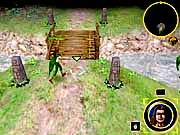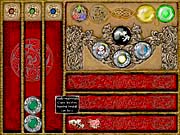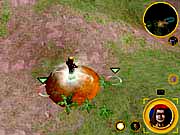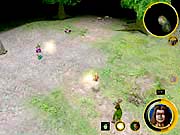When you play a fantasy game, it can be great fun to bash heads as an ax-wielding barbarian, but when you think of the fantasy genre, you probably first think of magic. If anything symbolizes the escape from the ordinary into a wondrous world of high adventure, it's a wizard or sorceress bending natural laws to summon strange creatures or harness the elements. If that's true, then Magic & Mayhem: The Art of Magic taps directly into the core appeal of the fantasy genre by letting you play as a wizard whose chief goal is combating fellow spellcasters. The Art of Magic is a sequel to Magic & Mayhem (1999), designed by Mythos Games of X-COM fame. This time around, developers Charybdis and later Climax were at the helm, creating a real-time strategy/role-playing hybrid. The Art of Magic takes many of the core concepts of its predecessor, adds a new 3D engine, and comes up with an interesting game whose every strength seems to be hurt by a related weakness.

In The Art of Magic, you play as Aurax, a young man who has just woken up after a long night of celebrating his coming of age with fellow villagers. He's also awakened to troubled times. In years past, three magic orbs created by a great wizard kept the world's three realms of law, chaos, and neutrality in balance. With the mysterious death of the neutral druid leader and the destruction of the orb he guarded, the forces of chaos begin a campaign of aggression. When the game opens, they're on the rampage in Aurax's homeland, the druids' neutral realm. Against this backdrop of warfare, Aurax has a more personal problem: His sister, Nadia, has recently disappeared. To Aurax's surprise, it turns out that she's skilled in the ways of magic, and now it's Aurax's turn to learn these arcane secrets and rescue his sister.
In real time, you lead Aurax across this fantasy landscape, dueling other wizards and their followers. You'll have the aid of NPC companions, as well as magical minions you learn to summon, such as eagles, dragons, and boulder-hurling giants. Aurax's quest unfolds as part of a branching campaign with more than 30 reasonably diverse missions. Some play like big strategic battles, while stealth missions give the game some puzzlelike elements, as in Pyro Studios' Commandos games. In addition to the campaign, you can play a highly configurable "battle" (skirmish) mode on 25 different maps with up to seven competing wizards. These can be controlled by the computer, which plays with welcome aggression, or by other humans online or over a LAN.
Akin to a character from an RPG, Aurax has three stats that you boost with experience gained from completing each of the campaign's levels. Health determines the damage that Aurax can sustain. Control limit determines the number of creatures you can command at once. Mana, the fantasy genre's sloppy catchall term for some sort of mysterious magical power, determines the power and number of spells you can cast in a short span. Also like in an RPG, you pick up items scattered across the landscape, including spell ingredients, "mana sprites" to boost your mana reserves, and food to replenish health. It can be pretty funny to see two powerful sorcerers furiously munching apples and fish during a magic duel.

The Art of Magic's spell system is the game's most interesting element and features more than 50 different spells. The game emphasizes strategic and creative forethought in its magic system. Between levels of the campaign or before you begin a skirmish, you access a portmanteau (spell book) to ready the spells you think you'll need in the coming level. Your portmanteau has talismans aligned in columns according to law, chaos, and neutrality. Into these talismans you place spell ingredients--like deadly nightshade, brimstone, or psilocybin--that you find during missions, thereby creating new spells. Depending on the alignment of the chosen talisman, the same ingredient can create totally different spells. So, psilocybin (from "magic mushrooms," no less) can be used to create spells that summon zombies, eagles, or fairies. Other spells can heal units, call down meteors, morph a wizard into another creature, and more. You really see the full possibilities of the spell system much more readily in battle mode than in the campaign, where you're stuck with very limited powers for quite a while.
Despite the emphasis on sorcery, The Art of Magic feels much like a traditional RTS too, with simple point-and-click attacks, green/red health bars over characters' heads, control-click unit grouping, and so forth. You'll fight to control vital resources, but instead of the usual RTS crystals or ore, you try to find mana-generating "places of power" and then hold them by placing at least one of your units on it. The more places of power you control at once, the greater your mana recharge rate, which is a key to winning battles. Fighting for and holding these mana sources forms the core strategic concern of the game, and it nicely balances and works in concert with the game's tactical-level combat. Fighting for places of power can proceed at a slow pace, though, regardless of the game speed setting you choose. It can sometimes feel like a dull war of attrition.
Fighting for places of power, waging spell battles, or just making a character move around can be a chore because of the game's awkward interface. Your wizards can't run without the aid of a spell; they only trudge about casually as enemies assault them. Dodging attacks is more difficult than it needs to be, thanks to that languid pace and the time it takes for a unit to change direction. Other interface problems can cause difficulties in combat too. After casting a spell, it's too easy to make your wizard cast it again when you want to make the character move. Also, some commands lack hotkeys, and you can't reconfigure the ones you do get. On the bright side, you can alter the game speed and issue commands while paused.

The Art of Magic's camera also proves to be a hindrance. As you zoom in and out, the view automatically tilts. With the camera zoomed all the way out, you get a top-down view, and with it zoomed all the way in, you get an intimate view akin to a third-person shooter. It's a shame you can't alter the angle independently of the zoom to provide the best view for each situation. Also, the camera rotates very slowly, particularly if you use the mouse to control it instead of the keyboard. A more serious problem with the camera arises from buildings, trees, and other scenery blocking your view. You have to manually toggle roofs and other obstructions on and off. It would be better if they temporarily faded away on their own when units moved under or behind them, as in games like Diablo II.
Even beyond the camera, the Art of Magic's new 3D engine isn't quite as magical as it could be. More than anything, the game looks remarkably like a tabletop fantasy miniatures game come to life. The levels can look eerily like photos of finely detailed model dioramas. It's a strange and memorable effect, but at the same time, the game lacks the sort of original artistic vision you find in games like Sacrifice. Still, some of the detailed terrain textures and spell effects are impressive in their own right, particularly the vicious "dragon's breath" fireballs you can cast. Their sooty smoke trails look remarkably lifelike. Some textures, like rippling water, start to look pixelated when viewed up close, though. The fog of war creates an awkward effect too. Areas where your units stand look as if they're illuminated by spotlights, while the unexplored areas seem to be shrouded by pitch-black night. The effect looks very artificial and awkward.
The 3D models used for trees, huts, and so forth look blocky, and the low-polygon characters tend to look horribly puppetlike with their stilted animations. These can render humorous those scenes that should be heartbreaking, like when an important character keeps jerking his foot mechanically as he dies. The subpar animations also make combat scenes appear lifeless. It's too bad more effort wasn't placed into character models and animation instead of gee-whiz particle effects.

The game's sound leaves you with the overwhelming impression of...not much, actually. It's functional but ultimately bland and forgettable, outside of a couple of interesting music tracks. The voice acting is usually competent at best. When Nadia tells Aurax that the living dead are attacking their family's village, she doesn't evince a drop of emotion. She may as well have been asking Aurax to pass the saltshaker at dinner. It doesn't help that the dialogue itself so often sounds like it was taken from a poorly written children's cartoon.
The Art of Magic's uneven presentation is indicative of the game as a whole. The RPG elements don't get as much attention as they deserve, and the gameworld and characters are a mishmash of hackneyed, third-rate Tolkienesque fantasy. The RTS elements aren't particularly novel or sophisticated either. The spell system is interesting in theory but can be a bit dull in practice in the campaign, yet much more fun in the battle mode. The campaign levels aren't balanced particularly well, with some too easy and others tediously long or frustratingly hard. The interface works passably, but it often gets in the way of itself. The visuals offer some really flashy effects but are let down by the character models, animations, and camera. The interesting features of Magic & Mayhem: The Art of Magic's don't gel into a truly satisfying game design, but they're entertaining as long as you don't set your sights too high.